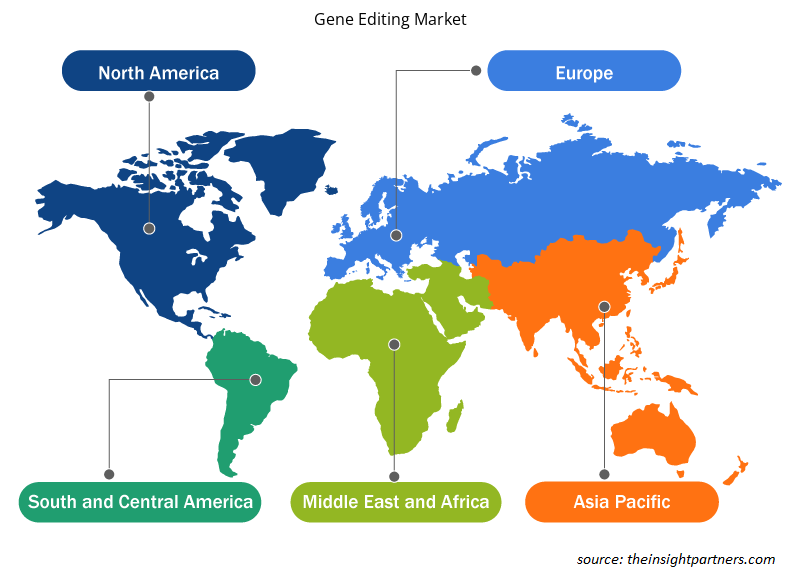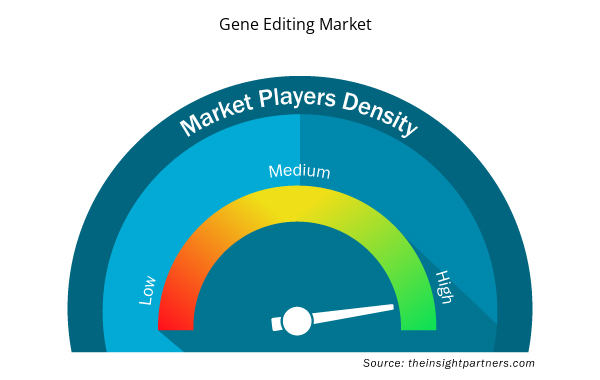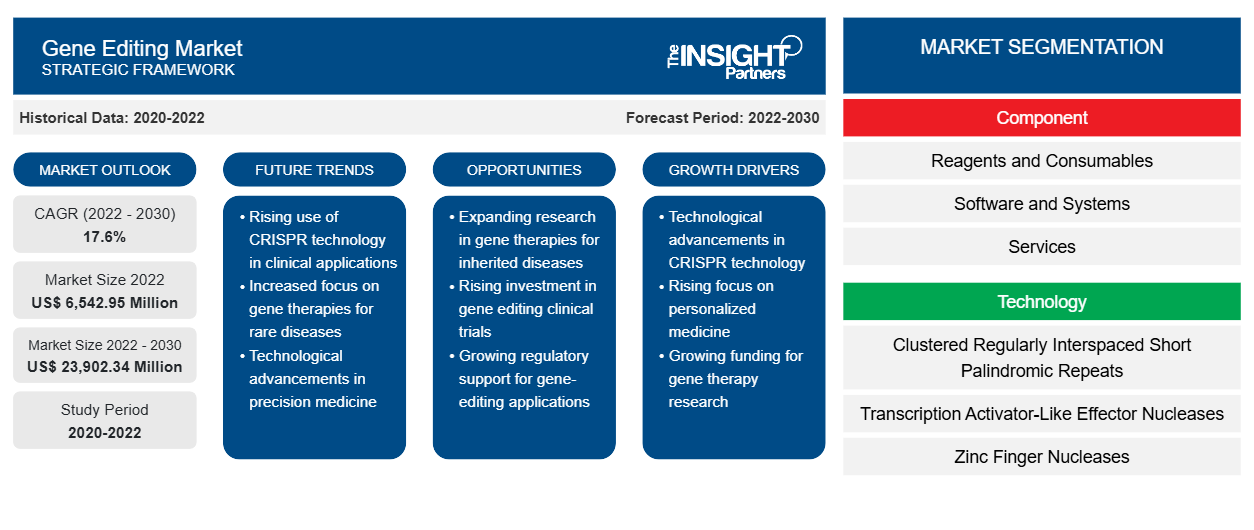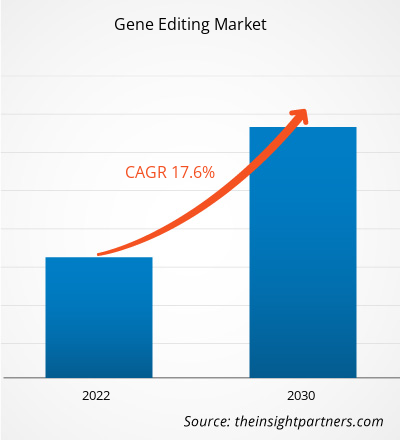[研究报告] 基因编辑市场规模预计将从 2022 年的 65.4295 亿美元增长到 2030 年的 239.0234 亿美元;预计 2022-2030 年期间的复合年增长率为 17.6%。CAGR of 17.6% during 2022–2030.
市场洞察和分析师观点:
基因编辑,也称为基因组编辑,是一种使用多种方法修改生物体 DNA 的技术。囊性纤维化、镰状细胞病、癌症等疾病可以通过基因编辑来治疗和预防。预计政府资金增加、基因组学项目数量增加以及基因组编辑技术日益普及将推动基因编辑市场的增长。
增长动力:
癌症发病率的不断上升给世界各地的医疗保健系统带来了负担。根据世界卫生组织 (WHO) 的数据,癌症是全球最大的死亡原因之一,2020 年约有 1000 万人死亡。根据美国癌症协会的数据,2021 年美国新增癌症病例约 1,898,160 例,癌症死亡病例约 608,570 例。近 10% 至 20% 的癌症与遗传或家族遗传的基因突变有关。在美国诊断出的癌症中,约有 5-10% 与遗传性癌症综合征有关。在美国,预计 2023 年将出现约 1,958,310 例新癌症病例和 609,820 例癌症死亡病例。此外,根据国际癌症研究机构的数据,到 2040 年,新发癌症发病率预计将达到 3020 万。根据 2020 年 7 月发表的题为“聚焦中国基因治疗”的研究,该国有超过 5700 万人患有遗传病,每年记录的癌症新病例约为 400 万例。
遗传病的发病率在世界范围内不断上升,严重影响着人们的健康。大多数遗传病都是罕见病,是由人类基因组成发生突变而引起的。根据谢菲尔德大学的研究,全球约有 3 亿人患有遗传病。2022 年,美国 MJH Life Sciences 的一份报告估计,全球每年有 30 万新生儿患有镰状细胞病 (SCD),占全球人口的 ∼5%。根据美国国家医学图书馆发表的一项关于镰状细胞病的研究,预计到 2050 年将有 40 万新生儿患有镰状细胞病。
根据 2023 年 8 月发表的一项名为“镰状细胞病”的研究,每 500 名非裔美国人中就有 1 人患有镰状细胞病。2020 年 6 月,根据瑞士诺华公司 (Novartis AG) 的报告,英国约有 15,000 人患有镰状细胞病,每年有 270 名新生儿被诊断出患有这种疾病。此外,这种疾病在印度等新兴国家最为普遍。在印度的部落社区中,约有 1800 万人患有镰状细胞性状 (SCT),140 万人患有镰状细胞病。
目前,许多癌症生物学研究都使用成簇的规律间隔短回文重复序列 (CRISPR) 作为标准方法。该技术还被用于增强癌症免疫疗法(例如 CAR-T 细胞疗法)的有效性和安全性。
CRISPR/Cas9 系统已被证明可有效治疗转移性肿瘤,这是发现癌症治愈方法的重要一步。CRISPR-LNP 系统包含一个信使 RNA,该 RNA 编码 Cas9 CRISPR 酶,这是一种可切割细胞 DNA 的分子剪刀。
尖端基因编辑技术在治疗镰状细胞性贫血等可怕疾病方面具有巨大潜力。CRISPR-Cas9 等技术的进步为精确高效的基因编辑铺平了道路,使纠正基因突变和修改致病基因成为可能。因此,预计在预测期内,癌症和其他遗传疾病的发病率不断上升将推动基因编辑市场的增长。
定制此报告以满足您的需求
您可以免费定制任何报告,包括本报告的部分内容、国家级分析、Excel 数据包,以及为初创企业和大学提供优惠和折扣
- 获取此报告的关键市场趋势。这个免费样品将包括数据分析,从市场趋势到估计和预测。
报告细分和范围:
基因编辑市场根据组件、技术、应用、最终用户和地理位置进行细分。根据组件,基因编辑市场分为试剂和耗材、软件和系统以及服务。根据技术,基因编辑市场分为成簇的规则间隔短回文重复序列、转录激活因子样效应物核酸酶、锌指核酸酶和其他技术。根据应用,基因编辑市场分为基因工程和临床应用。根据最终用户,基因编辑市场分为制药公司和生物技术公司、学术和政府研究机构以及临床研究组织。根据地理位置,基因编辑市场分为北美(美国、加拿大和墨西哥)、欧洲(法国、德国、英国、西班牙、意大利和欧洲其他地区)、亚太地区(中国、印度、日本、澳大利亚、韩国和亚太其他地区)、中东和非洲(沙特阿拉伯、阿联酋、南非和中东和非洲其他地区)以及南美洲和中美洲(巴西、阿根廷和南美洲和中美洲其他地区)。
节段分析:
基因编辑市场按组成部分分为试剂和耗材、软件和系统以及服务。服务部门在 2022 年占据了最大的市场份额。然而,试剂和耗材部门预计将在 2022-2030 年期间实现市场最高复合年增长率。
根据技术,基因编辑市场细分为成簇的规律间隔短回文重复序列、转录激活因子样效应物核酸酶、锌指核酸酶和其他技术。2022 年,成簇的规律间隔短回文重复序列部分占据了最大的市场份额,预计在 2022-2030 年期间将录得最快的复合年增长率。
根据应用,基因编辑市场分为基因工程和临床应用。2022 年,临床应用领域占据了更大的市场份额,预计在 2022-2030 年期间将以更高的复合年增长率增长。
根据最终用户,基因编辑市场分为制药公司和生物技术公司、学术和政府研究机构以及临床研究组织。制药公司和生物技术公司在 2022 年占据了最大的市场份额,预计在 2022-2030 年期间将实现最高的复合年增长率。
区域分析:
基因编辑市场主要分为北美、欧洲、亚太地区、南美和中美以及中东和非洲。2022 年,北美占据了相当大的市场份额。2022 年,美国占据了该地区最大的市场份额。北美市场的增长归因于对基因编辑技术研发的投资不断增加、生物技术和制药公司致力于开发基因组编辑技术以及产品审批不断增加。此外,遗传疾病的日益流行和采用先进的基因疗法治疗慢性病估计将推动该国市场的增长。例如,根据囊性纤维化基金会 2022 年 7 月发布的估计,美国有 40,000 人患有囊性纤维化。此外,根据疾病控制和预防中心 (CDC) 的数据,2020 年美国诊断出约 1,603,844 例新癌症病例,癌症死亡人数为 602,347 人。每10万人中,有403例新发癌症病例。
2020 年 10 月,默克与 Takara Bio USA, Inc. 签署了许可协议。默克授权 Takara 使用其 CRISPR 技术开发载体和其他创新产品,以支持使用 CRISPR 和工程服务的研究,特别是干细胞研究。因此,这些因素在预测期内支持该地区市场的增长。
基因编辑市场区域洞察
Insight Partners 的分析师已详细解释了预测期内影响基因编辑市场的区域趋势和因素。本节还讨论了北美、欧洲、亚太地区、中东和非洲以及南美和中美洲的基因编辑市场细分和地理位置。

- 获取基因编辑市场的区域特定数据
基因编辑市场报告范围
| 报告属性 | 细节 |
|---|---|
| 2022 年市场规模 | 65.4295亿美元 |
| 2030 年市场规模 | 239.0234亿美元 |
| 全球复合年增长率(2022 - 2030 年) | 17.6% |
| 史料 | 2020-2022 |
| 预测期 | 2022-2030 |
| 涵盖的领域 | 按组件
|
| 覆盖地区和国家 | 北美
|
| 市场领导者和主要公司简介 |
|
市场参与者密度:了解其对商业动态的影响
基因编辑市场正在快速增长,这得益于终端用户需求的不断增长,而这些需求又源于消费者偏好的不断变化、技术进步以及对产品优势的认识不断提高等因素。随着需求的增加,企业正在扩大其产品范围,进行创新以满足消费者的需求,并利用新兴趋势,从而进一步推动市场增长。
市场参与者密度是指在特定市场或行业内运营的企业或公司的分布情况。它表明在给定市场空间中,相对于其规模或总市场价值,有多少竞争对手(市场参与者)存在。
在基因编辑市场运营的主要公司有:
- 赛默飞世尔科技
- 金斯瑞
- 龙沙
- 默克公司
- CRISPR 治疗
免责声明:上面列出的公司没有按照任何特定顺序排列。

- 了解基因编辑市场的主要参与者概况
行业发展和未来机遇:
以下列出了全球基因编辑市场的主要参与者采取的各种举措:
- 2022 年 4 月,赛默飞世尔科技推出了 GMP 制造的 Gibco CTS TrueCut Cas9 蛋白,帮助研究人员在使用基因组编辑工具时满足严格的质量要求。对于使用 CRISPR-Cas9 基因组编辑的 CAR T 细胞治疗研究来说,这是一个有希望的选择,因为它在人类原代 T 细胞中始终提供高于 90% 的功效,并在所有受检细胞系中提供高编辑效率。
竞争格局和重点公司:
Thermo Fisher Scientific、GenScript、Lonza、Merck KGaA、CRISPR Therapeutics、PerkinElmer Inc.、Agilent Technologies, Inc.、Precision Biosciences、Sangamo Therapeutics, Inc.、New England Biolabs 和 Novartis 是基因编辑市场的知名企业。这些公司专注于推出新的高科技产品、改进现有产品和扩大地域范围,以满足全球日益增长的消费者需求。
- 历史分析(2 年)、基准年、预测(7 年)及复合年增长率
- PEST 和 SWOT 分析
- 市场规模价值/数量 - 全球、区域、国家
- 行业和竞争格局
- Excel 数据集



Report Coverage
Revenue forecast, Company Analysis, Industry landscape, Growth factors, and Trends

Segment Covered
This text is related
to segments covered.

Regional Scope
North America, Europe, Asia Pacific, Middle East & Africa, South & Central America

Country Scope
This text is related
to country scope.
常见问题
The gene editing market majorly consists of the players, including Thermo Fisher Scientific; GenScript; Lonza; Merck KGaA; CRISPR Therapeutics; PerkinElmer Inc.; Agilent Technologies, Inc.; Precision Biosciences; Sangamo Therapeutics, Inc.; New England Biolabs; and Novartis.
The factors driving the growth of the gene editing market include the increase in cancer and other genetic disorders and growing investment in genetic research. However, the high cost of genomic equipment’s hampers the growth of the gene editing market.
Gene editing is a scientific method that is used to modify or alter the DNA of living organisms, including plants, bacteria, humans, animals, and others. Gene editing is done for research purposes, the treatment of diseases, and the biotechnological purpose. CRISPR is a genome-editing technology for diagnosing diseases. Gene editing technology has emerged as an effective technique to examine gene function, examine the pathophysiology of hereditary disorders, produce new gene therapeutic targets, breed varieties of crops, and others. Advances in technologies like CRISPR-Cas9 have paved the way for precise and efficient gene editing, enabling the potential to correct genetic mutations and modify disease-causing genes.
The gene editing market was valued at US$ 6,542.95 million in 2022.
The gene editing market is expected to be valued at US$ 23,902.34 million in 2030.
The global gene editing market is segmented on the basis of components, technology, application, and end users. Based on application, the market is segmented into genetic engineering and clinical applications. The clinical applications segment held a larger share of the market in 2022 and is anticipated to register a higher CAGR during the forecast period.
Trends and growth analysis reports related to Life Sciences : READ MORE..
The List of Companies - Gene Editing Market
- Thermo Fisher Scientific
- GenScript
- Lonza
- Merck KGaA
- CRISPR Therapeutics
- PerkinElmer Inc.
- Agilent Technologies Inc.
- Precision Biosciences
- Sangamo Therapeutics Inc.
- New England Biolabs
- Novartis
The Insight Partners performs research in 4 major stages: Data Collection & Secondary Research, Primary Research, Data Analysis and Data Triangulation & Final Review.
- Data Collection and Secondary Research:
As a market research and consulting firm operating from a decade, we have published and advised several client across the globe. First step for any study will start with an assessment of currently available data and insights from existing reports. Further, historical and current market information is collected from Investor Presentations, Annual Reports, SEC Filings, etc., and other information related to company’s performance and market positioning are gathered from Paid Databases (Factiva, Hoovers, and Reuters) and various other publications available in public domain.
Several associations trade associates, technical forums, institutes, societies and organization are accessed to gain technical as well as market related insights through their publications such as research papers, blogs and press releases related to the studies are referred to get cues about the market. Further, white papers, journals, magazines, and other news articles published in last 3 years are scrutinized and analyzed to understand the current market trends.
- Primary Research:
The primarily interview analysis comprise of data obtained from industry participants interview and answers to survey questions gathered by in-house primary team.
For primary research, interviews are conducted with industry experts/CEOs/Marketing Managers/VPs/Subject Matter Experts from both demand and supply side to get a 360-degree view of the market. The primary team conducts several interviews based on the complexity of the markets to understand the various market trends and dynamics which makes research more credible and precise.
A typical research interview fulfils the following functions:
- Provides first-hand information on the market size, market trends, growth trends, competitive landscape, and outlook
- Validates and strengthens in-house secondary research findings
- Develops the analysis team’s expertise and market understanding
Primary research involves email interactions and telephone interviews for each market, category, segment, and sub-segment across geographies. The participants who typically take part in such a process include, but are not limited to:
- Industry participants: VPs, business development managers, market intelligence managers and national sales managers
- Outside experts: Valuation experts, research analysts and key opinion leaders specializing in the electronics and semiconductor industry.
Below is the breakup of our primary respondents by company, designation, and region:

Once we receive the confirmation from primary research sources or primary respondents, we finalize the base year market estimation and forecast the data as per the macroeconomic and microeconomic factors assessed during data collection.
- Data Analysis:
Once data is validated through both secondary as well as primary respondents, we finalize the market estimations by hypothesis formulation and factor analysis at regional and country level.
- Macro-Economic Factor Analysis:
We analyse macroeconomic indicators such the gross domestic product (GDP), increase in the demand for goods and services across industries, technological advancement, regional economic growth, governmental policies, the influence of COVID-19, PEST analysis, and other aspects. This analysis aids in setting benchmarks for various nations/regions and approximating market splits. Additionally, the general trend of the aforementioned components aid in determining the market's development possibilities.
- Country Level Data:
Various factors that are especially aligned to the country are taken into account to determine the market size for a certain area and country, including the presence of vendors, such as headquarters and offices, the country's GDP, demand patterns, and industry growth. To comprehend the market dynamics for the nation, a number of growth variables, inhibitors, application areas, and current market trends are researched. The aforementioned elements aid in determining the country's overall market's growth potential.
- Company Profile:
The “Table of Contents” is formulated by listing and analyzing more than 25 - 30 companies operating in the market ecosystem across geographies. However, we profile only 10 companies as a standard practice in our syndicate reports. These 10 companies comprise leading, emerging, and regional players. Nonetheless, our analysis is not restricted to the 10 listed companies, we also analyze other companies present in the market to develop a holistic view and understand the prevailing trends. The “Company Profiles” section in the report covers key facts, business description, products & services, financial information, SWOT analysis, and key developments. The financial information presented is extracted from the annual reports and official documents of the publicly listed companies. Upon collecting the information for the sections of respective companies, we verify them via various primary sources and then compile the data in respective company profiles. The company level information helps us in deriving the base number as well as in forecasting the market size.
- Developing Base Number:
Aggregation of sales statistics (2020-2022) and macro-economic factor, and other secondary and primary research insights are utilized to arrive at base number and related market shares for 2022. The data gaps are identified in this step and relevant market data is analyzed, collected from paid primary interviews or databases. On finalizing the base year market size, forecasts are developed on the basis of macro-economic, industry and market growth factors and company level analysis.
- Data Triangulation and Final Review:
The market findings and base year market size calculations are validated from supply as well as demand side. Demand side validations are based on macro-economic factor analysis and benchmarks for respective regions and countries. In case of supply side validations, revenues of major companies are estimated (in case not available) based on industry benchmark, approximate number of employees, product portfolio, and primary interviews revenues are gathered. Further revenue from target product/service segment is assessed to avoid overshooting of market statistics. In case of heavy deviations between supply and demand side values, all thes steps are repeated to achieve synchronization.
We follow an iterative model, wherein we share our research findings with Subject Matter Experts (SME’s) and Key Opinion Leaders (KOLs) until consensus view of the market is not formulated – this model negates any drastic deviation in the opinions of experts. Only validated and universally acceptable research findings are quoted in our reports.
We have important check points that we use to validate our research findings – which we call – data triangulation, where we validate the information, we generate from secondary sources with primary interviews and then we re-validate with our internal data bases and Subject matter experts. This comprehensive model enables us to deliver high quality, reliable data in shortest possible time.


 获取此报告的免费样本
获取此报告的免费样本